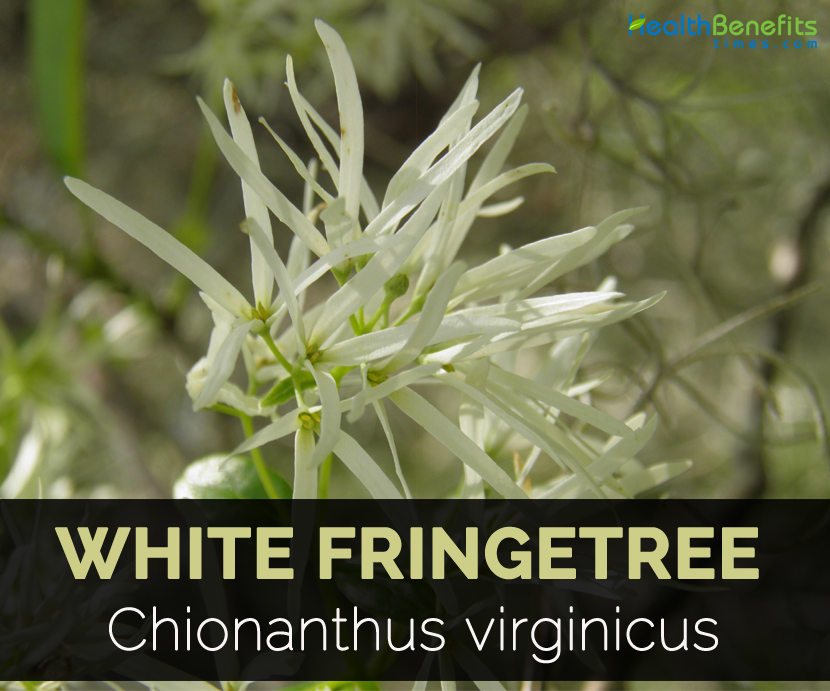| White fringetree Quick Facts | |
|---|---|
| Name: | White fringetree |
| Scientific Name: | Chionanthus virginicus |
| Origin | Eastern United States and ranges from Oklahoma, Arkansas, Texas and Louisiana, eastward to Florida and northward to Pennsylvania and New Jersey |
| Colors | Ovoid dark blue to purple drupe |
| Shapes | Egg-shaped, 1.5 to 2 centimetres (0.59 to 0.79 in) long |
| Name | White fringetree |
|---|---|
| Scientific Name | Chionanthus virginicus |
| Native | Eastern United States and ranges from Oklahoma, Arkansas, Texas and Louisiana, eastward to Florida and northward to Pennsylvania and New Jersey |
| Common/English Name | Old Man’s Beard, White Fringe, Snowdrop Tree, Poison Ash, Fringe Tree, Old Man’s Beard, White fringetree, Fringe Tree, Flowering ash, Snowflower-tree, Graybeard-tree, Sunflower-tree |
| Plant Growth Habit | Large shrub or slender tree |
| Plant Size | 10-20 feet tall x 10-20 feet wide |
| Bark | Thin, scaly, brown tinged |
| Leaf | Ovate or oblong, 7.5 to 20 centimetres (3.0 to 7.9 in) long and 2.5 to 10 centimetres (0.98 to 3.94 in) broad |
| Medicinal part | Root bark |
| Flowering Season | Spring |
| Buds | Light brown, ovate, acute, 3 millimetres (0.12 in) long |
| Flower | White, 6 to 8 inches long |
| Fruit shape & size | Egg-shaped, 1.5 to 2 centimetres (0.59 to 0.79 in) long |
| Fruit color | Ovoid dark blue to purple drupe |
| Fruit Season | Late summer |
Leaves
Leaves are simple, thick, opposite which grows 3 to 8 inches long and half as wide. They are narrow-elliptic to oblong or obovate-oblong having medium to dark green and waxy appearance. Leaves form very late in spring and turn dull yellow in fall before dropping.
Flower
Blossoms are fragrant which blooms late spring. They form in drooping clusters at the ends of branches in May to June. Flower has four long and narrow petals. Flowers are wispy, pure white and cloudlike. Flowers are pollinated by insects. Trees are dioecious with male and female flowers on separate plants. Male plants are impressive in bloom due to longer petals but female plants bear blue and plum like fruits which attracts wildlife.
Fruit
Female plants forms a cluster of ½ to 2/3 inch long, fleshy, dark blue and plum like drupes in August to September. The fleshy drupe contains a single large seed.
Bark
Bark is pale gray or brown and smooth on young branches. Mature trunks and branches are furrowed, ridged and develops an attractive craggy like with age.
Uses
Generally useful in stomach and liver disorders and in poor digestive functions, by slightly influencing all the organs engaged in digestion and blood making. A specific in spleen malfunction, and for congestion of the liver when failure to excrete the residue from food, thus resulting in constipation (one of the reasons for gall-stone, jaundice and stomach inefficiency). In some, the involuntary muscles of the heart will also be impaired by the inactivity of the above mentioned.
In pregnancy, when indications of yellow skin, the white of the eyes are of a yellow colour, bilious colic, heartburn, etc., 5–10 drops in water before meals is indicated. Useful in malignant tumours of the stomach or bowels, and in uterine tumours, also in most chronic conditions of the liver and spleen.
Combine:
Tincture of Golden seal (Hydrastis canadensis), 7–10 drops.
Tincture of Fringe tree (Chionanthus virginica), 3–7 drops.
Dose
10–20 drops in water before meals and at bedtime has proven effective.
In bilious colic it is best to first evacuate the stomach by giving an emetic dose of Lobelia and then to administer the above. The powdered root bark is used professionally; however, the cut root bark can be infused in hot water for ½ hr. and taken in small amounts throughout the day. Pulsatilla (Anemone) is also used in conjunction with Fringe tree.
Externally
The skin will respond to the application of an infusion of 1 oz. to 1 pint of water, when other attempts have failed. Also as an injection.
Homoeopathic Clinical
Tincture of the bark (which is the part employed and which contains saponin)—Constipation, Debility, Emaciation with liver disorder, Gall-stone colic, Headache, Jaundice, Liver (disease of, hypertrophy of), Malaria, Neurasthenia, Nursing women (complaints of).
Traditional uses
- Native Americans use the bark and dried roots for treating skin inflammations.
- Use the crushed bark for treating sores and wounds.
- Consume bark tea for reducing fever, relieve dyspepsia, fever, gallstones, jaundice, stimulate vomiting, treat colic, hepatitis, migraines, headache and malaria.
- Native Americans use the bark poultice for cleaning wounds, sores and skin irritations.
- Use the tincture made from bark and grain alcohol for jaundice.
- Apply the tea made from boiled bark topically for cuts, skin irritations and infections.
- Use the poultice made from bark for cuts, bruises and ulcers.
- It is used for treating oral ulcers and spongy gums and eye inflammations.
- Use tea as a herbal wash for bed sores, inflammation and various infections.
- It is used to stimulate appetite, digestion and chronic illness.
Side effects
Overdose causes frontal headaches, vomiting and slow pulse rate.
References:
https://www.itis.gov/servlet/SingleRpt/SingleRpt?search_topic=TSN&search_value=32950#null
https://en.wikipedia.org/wiki/Chionanthus_virginicus
https://plants.usda.gov/core/profile?symbol=CHVI3
https://medicinalgarden.trekbirmingham.com/chionanthus-virginicus/
https://bernheim.org/learn/trees-plants/bernheim-select-urban-trees/fringe-tree/
https://medicinalgarden.trekbirmingham.com/chionanthus-virginicus/
http://www.naturalmedicinalherbs.net/herbs/c/chionanthus-virginicus=fringe-tree.php
Comments
comments
